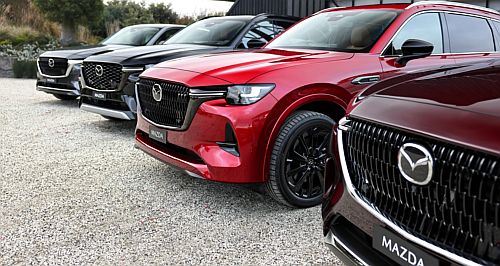Future models - MazdaMazda says no to off-road SUVLarge SUV rollout continues but Isuzu collab’ on BT-50 does not stretch to a Mazda MU-X25 Oct 2024 By SCOTT NEWMAN OFF-ROAD SUV sales are surging, but Mazda says there is no scope to expand its Isuzu relationship with a restyled version of the MU-X in a similar vein to its D-Max/BT-50 partnership.
The Ford Everest, Isuzu MU-X and Mitsubishi Pajero Sport have all surpassed their 2023 totals as of September this year and that is without accounting for the thousands who are awaiting the arrival of the new Toyota Prado.
Although an obvious gap in Mazda’s line-up, a four-wheel-drive wagon is one the brand has no intention of filling – Mazda Australia managing director Vinesh Bhindi gave a quick shake of the head in response to a question regarding whether Mazda’s partnership with Isuzu could be expanded to the MU-X SUV.
Mazda has instead concentrated on expanding its road-biased SUV line-up in a premium direction, the existing CX-60 and CX-90 to be joined imminently by the CX-70 and CX-80, making Australia one of the only markets to receive all four models.
To further confuse matters, the model line-up is not linear, the CX-80 being essentially a three-row version of the CX-60 and the CX-70 being a five-seat version of the CX-90. In terms of pricing, the hierarchy will be CX-60, CX-80, CX-70 and CX-90.
Of the quartet, it is the CX-80 that is expected to be the volume seller, replacing the sizeable three-row hole in Mazda’s line-up left by the end of CX-8 and CX-9 production.
These two six- or seven-seat SUVs proved very popular with buyers and leave Mazda Australia between 12,000 and 13,000 sales per annum to make up.
Mazda has priced the 10-variant CX-80 range from $54,950 before on-road costs to $87,200 + ORC, starting around $12K higher than the entry-level CX-8 and ending a similar amount north of the top-spec CX-9 (although much of that high-end pricing is due to an $11K premium for the plug-in hybrid drivetrain option).
As well as the plug-in hybrids, the CX-80 echoes the selection of six-cylinder turbo-petrol and turbo-diesel mild hybrid drivestrains found in the CX-60.
The other three models are tasked with retaining Mazda customers who would otherwise leave the brand. “We had premium outflows,” said Mazda Australia marketing director Alastair Doak.
“We knew we were losing customers beyond CX-5, so CX-60 is a destination beyond CX-5 and then we got offered CX-70, which gives us a destination beyond CX-60.”
While CX-70 seems redundant, given it is essentially a five-seat CX-90, Mazda’s research indicated that customers who did not want a three-row SUV bought something else rather than consider buying a seven seater but keeping the rear row folded down.
“We don’t see any confusion,” said Mr Doak. “The CX-80 tends to be a younger family, younger kids; the CX-90 slightly more affluent, tends to be older. We’re pretty comfortable that those two work well together, and then on the five-seat side you’ve got this natural walk-up all the way from CX-3 to CX-70.”  All future models Alfa Romeo Alfa Romeo Abarth Abarth Audi Audi Aston Martin Aston Martin BMW BMW Bentley Bentley Chrysler Chrysler Chevrolet Chevrolet Dodge Dodge Citroen Citroen Ferrari Ferrari DS DS Ford Ford Fiat Fiat FPV FPV Foton Foton Haval Haval Great Wall Great Wall Honda Honda Holden Holden Hyundai Hyundai HSV HSV Isuzu Isuzu Infiniti Infiniti Jeep Jeep Jaguar Jaguar Lamborghini Lamborghini Kia Kia Lexus Lexus Land Rover Land Rover Mazda Mazda Maserati Maserati Mercedes-Benz Mercedes-Benz McLaren McLaren Mini Mini Nissan Nissan Mitsubishi Mitsubishi Peugeot Peugeot Opel Opel Proton Proton Porsche Porsche Renault Renault Ram Ram Saab Saab Rolls-Royce Rolls-Royce Smart Smart Skoda Skoda Subaru Subaru SsangYong SsangYong Tesla Tesla Suzuki Suzuki Toyota Toyota Volvo VolvoMotor industry news |
Click to shareMazda modelsResearch Mazda All future models Alfa Romeo Alfa Romeo Abarth Abarth Audi Audi Aston Martin Aston Martin BMW BMW Bentley Bentley Chrysler Chrysler Chevrolet Chevrolet Dodge Dodge Citroen Citroen Ferrari Ferrari DS DS Ford Ford Fiat Fiat FPV FPV Foton Foton Haval Haval Great Wall Great Wall Honda Honda Holden Holden Hyundai Hyundai HSV HSV Isuzu Isuzu Infiniti Infiniti Jeep Jeep Jaguar Jaguar Lamborghini Lamborghini Kia Kia Lexus Lexus Land Rover Land Rover Mazda Mazda Maserati Maserati Mercedes-Benz Mercedes-Benz McLaren McLaren Mini Mini Nissan Nissan Mitsubishi Mitsubishi Peugeot Peugeot Opel Opel Proton Proton Porsche Porsche Renault Renault Ram Ram Saab Saab Rolls-Royce Rolls-Royce Smart Smart Skoda Skoda Subaru Subaru SsangYong SsangYong Tesla Tesla Suzuki Suzuki Toyota Toyota Volvo VolvoMotor industry news |














Facebook Twitter Instagram